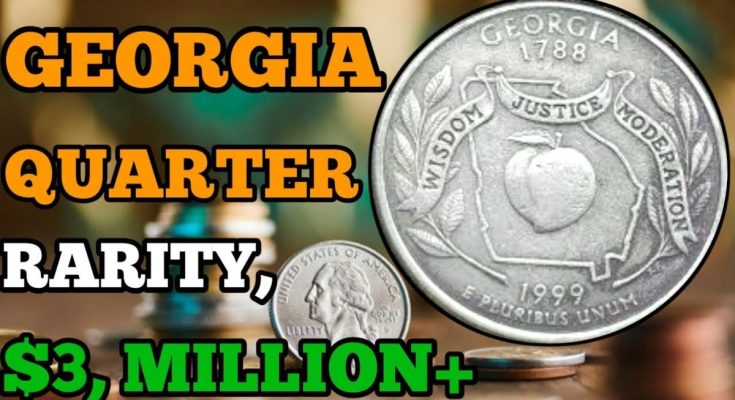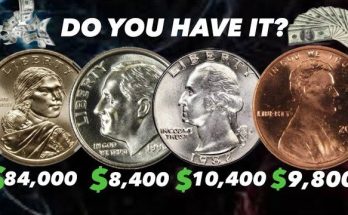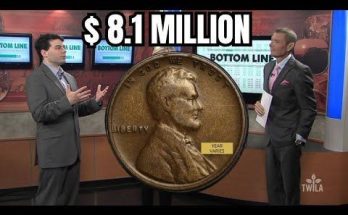Caption
The $10,000 Pocket Change: This seemingly ordinary 1999 Georgia State Quarter, featuring George Washington, could be one of the rarest and most valuable modern coins in existence, capable of fetching up to $10,000 at auction. Its staggering value is not due to its age, but a significant and fascinating minting mistake: it was accidentally struck on an experimental, off-metal planchet originally intended for the upcoming Sacagawea dollar coin. Learn how to spot this extremely rare error that turns a quarter into a small fortune.
Description: The Rare 1999 Georgia Quarter Error That’s Worth Up to $10,000
The year 1999 marked the launch of one of the most popular and historically significant coin series in modern American numismatics: the 50 State Quarters Program. The first state honored in this program was Delaware, followed by Pennsylvania, New Jersey, Georgia, and finally, Connecticut. Each coin in the series maintained the standard obverse design featuring a portrait of the nation’s first president, George Washington, but introduced a unique reverse design commemorating the history and identity of one of the 50 states. The coin in question, often referred to by collectors as the “1999 George quarter” for its obverse imagery, is officially the 1999 Georgia State Quarter.
The standard 1999 Georgia State Quarter’s reverse depicts a peach, the state’s well-known symbol, surrounded by an outline of the state itself and a banner featuring the state motto, “Wisdom, Justice, Moderation”. Despite their popularity, the vast majority of these state quarters minted in Philadelphia (‘P’) and Denver (‘D’) for general circulation are only worth their face value of $0.25. Uncirculated, high-grade examples (such as MS65) might only sell for approximately $5. However, a very small number of these coins were released with stunning minting mistakes, errors so profound and rare that they have propelled their value into the thousands of dollars.
The most sought-after and valuable error associated with the 1999 Georgia Quarter—the one that can turn pocket change into a cash windfall of up to $10,000—is the Off-Metal Planchet Error. This error occurred early in 1999 when the U.S. Mint was experimenting with a new, pale-colored golden alloy. This alloy was a test material that would eventually be used for the production of the new Sacagawea one-dollar coin, which launched in 2000. A handful of the Georgia quarters were accidentally struck on these experimental alloy discs, or “planchets,” and mistakenly released into circulation.
This accidental striking created a truly unique and visually distinct coin. The crucial identifiers for the $10,000 Georgia quarter error are:
- Color: Unlike the standard copper-nickel clad quarter which has a silvery-white appearance, the error coin will exhibit a distinct golden or greenish tint. This color is a direct result of the experimental metallic composition.
- Edge: Standard quarters are clad, meaning they have layers of different metals, resulting in a visible copper (orange-colored) stripe along the edge. The off-metal error coin will lack this copper stripe.
- Weight and Thickness: The experimental alloy planchet was different in composition and density than the standard quarter planchet. As a result, the error coin will typically weigh more, between 5.9 and 6.3 grams, compared to the normal quarter’s weight of 5.67 grams. It may also appear noticeably thicker than a regular quarter.
The incredible value is derived from the coin’s extreme rarity and the compelling story behind the error. Because the error was discovered quickly and the use of the experimental planchet was not approved for the quarter program, only a limited number of these mistakes were ever released. Collectors pay a massive premium for an authenticated example. While the reported maximum value for this specific error is around $10,000, another major planchet error—a 1999 Georgia quarter struck on a foreign planchet—has sold for $4,100, and a high-grade off-metal strike sold for $4,200, confirming the strong collector demand for these planchet mistakes.
While the off-metal error is the “holy grail,” other, less valuable, errors do exist. For example, a 1999-D Georgia quarter with a Rotated Die error (where the reverse is noticeably askew from the obverse) has been valued at approximately $200 for a high-grade example. Additionally, coins with major Off-Center Strikes (30% or greater misalignment) can be worth up to $150, while more common errors like minor doubling or die cracks usually only add a few dollars to the value.
If a collector or casual coin-checker believes they have found one of the valuable error coins, it is essential to handle the coin by the edges and seek professional authentication. Spending a potential $10,000 coin would be a devastating mistake. Submitting the coin to a reputable grading service, such as the Professional Coin Grading Service (PCGS) or the Numismatic Guaranty Corporation (NGC), is the best way to verify the error, establish its condition, and achieve its maximum market value when selling to an aggressive market of dedicated numismatists.



